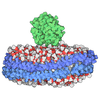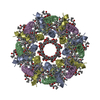[English] 日本語
 Yorodumi
Yorodumi- PDB-7tuw: LH2-LH3 antenna in anti parallel configuration embedded in a nanodisc -
+ Open data
Open data
- Basic information
Basic information
| Entry | Database: PDB / ID: 7tuw | ||||||||||||||||||
|---|---|---|---|---|---|---|---|---|---|---|---|---|---|---|---|---|---|---|---|
| Title | LH2-LH3 antenna in anti parallel configuration embedded in a nanodisc | ||||||||||||||||||
 Components Components |
| ||||||||||||||||||
 Keywords Keywords | PHOTOSYNTHESIS / antenna / membrane protein / nanodisc / bacteriochlorophyll | ||||||||||||||||||
| Function / homology |  Function and homology information Function and homology informationorganelle inner membrane / plasma membrane light-harvesting complex / bacteriochlorophyll binding / photosynthesis, light reaction / electron transporter, transferring electrons within the cyclic electron transport pathway of photosynthesis activity / metal ion binding / plasma membrane Similarity search - Function | ||||||||||||||||||
| Biological species |  Magnetospirillum molischianum (magnetotactic) Magnetospirillum molischianum (magnetotactic) | ||||||||||||||||||
| Method | ELECTRON MICROSCOPY / single particle reconstruction / cryo EM / Resolution: 8.2 Å | ||||||||||||||||||
 Authors Authors | Toporik, H. / Harris, D. / Schlau-Cohen, G.S. / Mazor, Y. | ||||||||||||||||||
| Funding support |  United States, 5items United States, 5items
| ||||||||||||||||||
 Citation Citation |  Journal: Proc Natl Acad Sci U S A / Year: 2023 Journal: Proc Natl Acad Sci U S A / Year: 2023Title: Elucidating interprotein energy transfer dynamics within the antenna network from purple bacteria. Authors: Dihao Wang / Olivia C Fiebig / Dvir Harris / Hila Toporik / Yi Ji / Chern Chuang / Muath Nairat / Ashley L Tong / John I Ogren / Stephanie M Hart / Jianshu Cao / James N Sturgis / Yuval ...Authors: Dihao Wang / Olivia C Fiebig / Dvir Harris / Hila Toporik / Yi Ji / Chern Chuang / Muath Nairat / Ashley L Tong / John I Ogren / Stephanie M Hart / Jianshu Cao / James N Sturgis / Yuval Mazor / Gabriela S Schlau-Cohen /   Abstract: In photosynthesis, absorbed light energy transfers through a network of antenna proteins with near-unity quantum efficiency to reach the reaction center, which initiates the downstream biochemical ...In photosynthesis, absorbed light energy transfers through a network of antenna proteins with near-unity quantum efficiency to reach the reaction center, which initiates the downstream biochemical reactions. While the energy transfer dynamics within individual antenna proteins have been extensively studied over the past decades, the dynamics between the proteins are poorly understood due to the heterogeneous organization of the network. Previously reported timescales averaged over such heterogeneity, obscuring individual interprotein energy transfer steps. Here, we isolated and interrogated interprotein energy transfer by embedding two variants of the primary antenna protein from purple bacteria, light-harvesting complex 2 (LH2), together into a near-native membrane disc, known as a nanodisc. We integrated ultrafast transient absorption spectroscopy, quantum dynamics simulations, and cryogenic electron microscopy to determine interprotein energy transfer timescales. By varying the diameter of the nanodiscs, we replicated a range of distances between the proteins. The closest distance possible between neighboring LH2, which is the most common in native membranes, is 25 Å and resulted in a timescale of 5.7 ps. Larger distances of 28 to 31 Å resulted in timescales of 10 to 14 ps. Corresponding simulations showed that the fast energy transfer steps between closely spaced LH2 increase transport distances by ∼15%. Overall, our results introduce a framework for well-controlled studies of interprotein energy transfer dynamics and suggest that protein pairs serve as the primary pathway for the efficient transport of solar energy. | ||||||||||||||||||
| History |
|
- Structure visualization
Structure visualization
| Structure viewer | Molecule:  Molmil Molmil Jmol/JSmol Jmol/JSmol |
|---|
- Downloads & links
Downloads & links
- Download
Download
| PDBx/mmCIF format |  7tuw.cif.gz 7tuw.cif.gz | 289.8 KB | Display |  PDBx/mmCIF format PDBx/mmCIF format |
|---|---|---|---|---|
| PDB format |  pdb7tuw.ent.gz pdb7tuw.ent.gz | 213.4 KB | Display |  PDB format PDB format |
| PDBx/mmJSON format |  7tuw.json.gz 7tuw.json.gz | Tree view |  PDBx/mmJSON format PDBx/mmJSON format | |
| Others |  Other downloads Other downloads |
-Validation report
| Summary document |  7tuw_validation.pdf.gz 7tuw_validation.pdf.gz | 3.3 MB | Display |  wwPDB validaton report wwPDB validaton report |
|---|---|---|---|---|
| Full document |  7tuw_full_validation.pdf.gz 7tuw_full_validation.pdf.gz | 3.4 MB | Display | |
| Data in XML |  7tuw_validation.xml.gz 7tuw_validation.xml.gz | 49.3 KB | Display | |
| Data in CIF |  7tuw_validation.cif.gz 7tuw_validation.cif.gz | 74.9 KB | Display | |
| Arichive directory |  https://data.pdbj.org/pub/pdb/validation_reports/tu/7tuw https://data.pdbj.org/pub/pdb/validation_reports/tu/7tuw ftp://data.pdbj.org/pub/pdb/validation_reports/tu/7tuw ftp://data.pdbj.org/pub/pdb/validation_reports/tu/7tuw | HTTPS FTP |
-Related structure data
| Related structure data |  26134MC 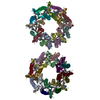 7tv3C 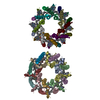 8fb9C  8fbbC M: map data used to model this data C: citing same article ( |
|---|---|
| Similar structure data | Similarity search - Function & homology  F&H Search F&H Search |
- Links
Links
- Assembly
Assembly
| Deposited unit | 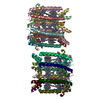
|
|---|---|
| 1 |
|
- Components
Components
-Light-harvesting protein B800-820 ... , 2 types, 16 molecules ADCGIKceBEFHJLdf
| #1: Protein | Mass: 6219.315 Da / Num. of mol.: 8 / Source method: isolated from a natural source Source: (natural)  Magnetospirillum molischianum (magnetotactic) Magnetospirillum molischianum (magnetotactic)References: UniProt: Q7M119 #2: Protein/peptide | Mass: 5252.069 Da / Num. of mol.: 8 / Source method: isolated from a natural source Source: (natural)  Magnetospirillum molischianum (magnetotactic) Magnetospirillum molischianum (magnetotactic)References: UniProt: Q7M158 |
|---|
-Light-harvesting protein B-800/850 ... , 2 types, 16 molecules MOQSUWYaNPRTVXZb
| #3: Protein | Mass: 6076.175 Da / Num. of mol.: 8 / Source method: isolated from a natural source Source: (natural)  Magnetospirillum molischianum (magnetotactic) Magnetospirillum molischianum (magnetotactic)References: UniProt: P97253 #4: Protein/peptide | Mass: 5252.069 Da / Num. of mol.: 8 / Source method: isolated from a natural source Source: (natural)  Magnetospirillum molischianum (magnetotactic) Magnetospirillum molischianum (magnetotactic)References: UniProt: P95673 |
|---|
-Non-polymers , 2 types, 64 molecules 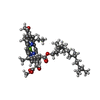


| #5: Chemical | ChemComp-BCL / #6: Chemical | ChemComp-LYC / |
|---|
-Details
| Has ligand of interest | Y |
|---|
-Experimental details
-Experiment
| Experiment | Method: ELECTRON MICROSCOPY |
|---|---|
| EM experiment | Aggregation state: PARTICLE / 3D reconstruction method: single particle reconstruction |
- Sample preparation
Sample preparation
| Component | Name: LH2 and LH3 antennae / Type: COMPLEX / Entity ID: #1-#4 / Source: MULTIPLE SOURCES |
|---|---|
| Molecular weight | Experimental value: NO |
| Source (natural) | Organism:  Magnetospirillum molischianum (magnetotactic) Magnetospirillum molischianum (magnetotactic) |
| Buffer solution | pH: 7.5 |
| Specimen | Embedding applied: NO / Shadowing applied: NO / Staining applied: NO / Vitrification applied: YES |
| Vitrification | Cryogen name: ETHANE |
- Electron microscopy imaging
Electron microscopy imaging
| Experimental equipment |  Model: Talos Arctica / Image courtesy: FEI Company |
|---|---|
| Microscopy | Model: FEI TALOS ARCTICA |
| Electron gun | Electron source:  FIELD EMISSION GUN / Accelerating voltage: 200 kV / Illumination mode: FLOOD BEAM FIELD EMISSION GUN / Accelerating voltage: 200 kV / Illumination mode: FLOOD BEAM |
| Electron lens | Mode: BRIGHT FIELD / Nominal defocus max: 3400 nm / Nominal defocus min: 1000 nm |
| Image recording | Electron dose: 54.56 e/Å2 / Film or detector model: FEI FALCON III (4k x 4k) |
- Processing
Processing
| EM software |
| ||||||||||||
|---|---|---|---|---|---|---|---|---|---|---|---|---|---|
| CTF correction | Type: PHASE FLIPPING ONLY | ||||||||||||
| 3D reconstruction | Resolution: 8.2 Å / Resolution method: FSC 0.143 CUT-OFF / Num. of particles: 71566 / Symmetry type: POINT | ||||||||||||
| Atomic model building | Protocol: RIGID BODY FIT | ||||||||||||
| Atomic model building | PDB-ID: 1LGH Accession code: 1LGH / Source name: PDB / Type: experimental model |
 Movie
Movie Controller
Controller





 PDBj
PDBj